人教版七年级下册Unit 4 Don’t eat in class. Section A Grammar Focus-3c-课件(共44张PPT)
文档属性
| 名称 | 人教版七年级下册Unit 4 Don’t eat in class. Section A Grammar Focus-3c-课件(共44张PPT) |  | |
| 格式 | pptx | ||
| 文件大小 | 1.8MB | ||
| 资源类型 | 教案 | ||
| 版本资源 | 人教新目标(Go for it)版 | ||
| 科目 | 英语 | ||
| 更新时间 | 2022-11-08 15:27:21 | ||
图片预览

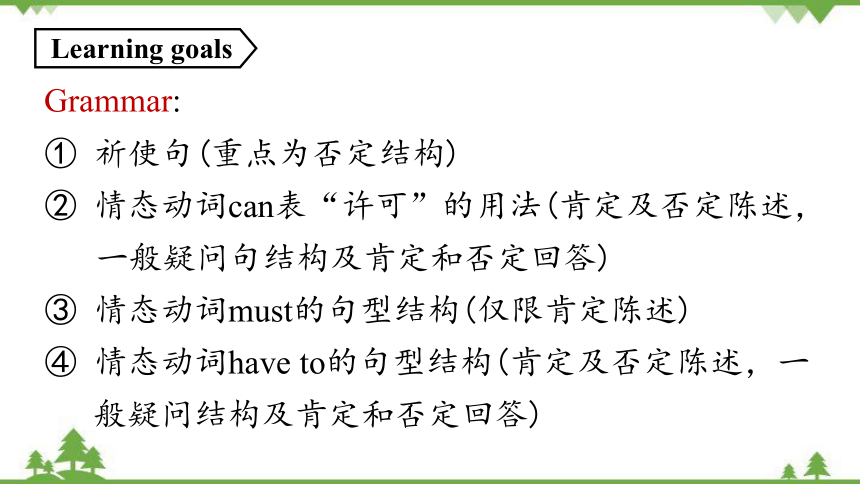
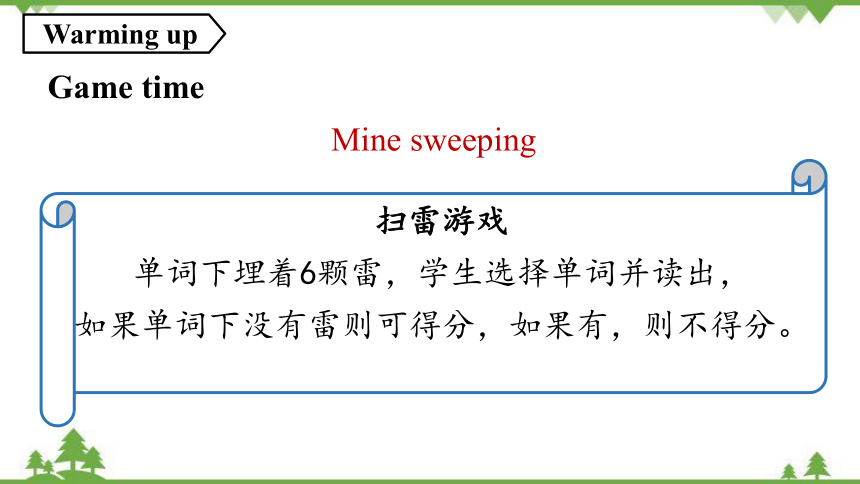
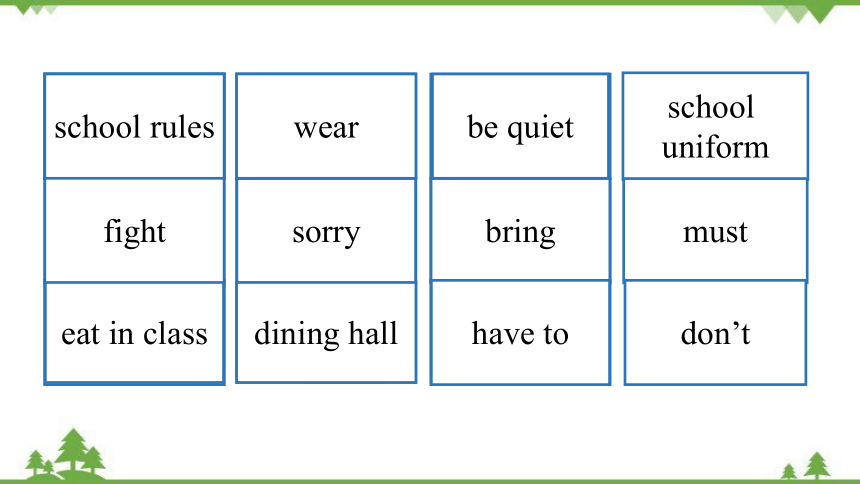

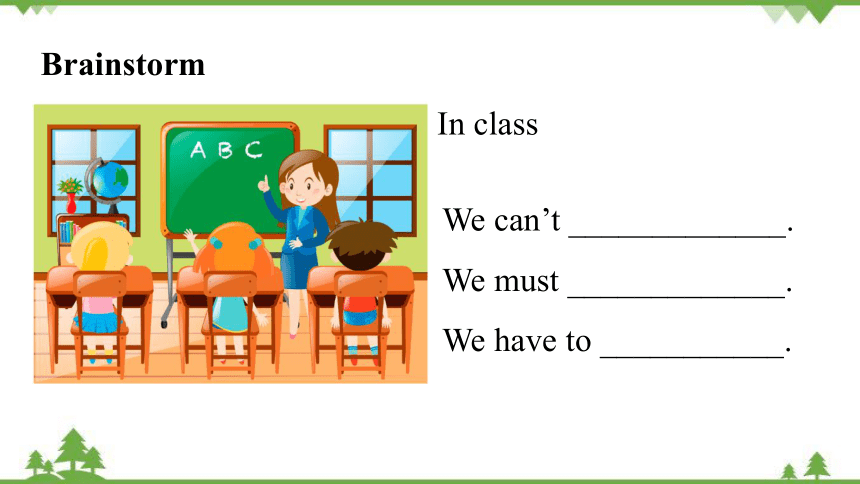
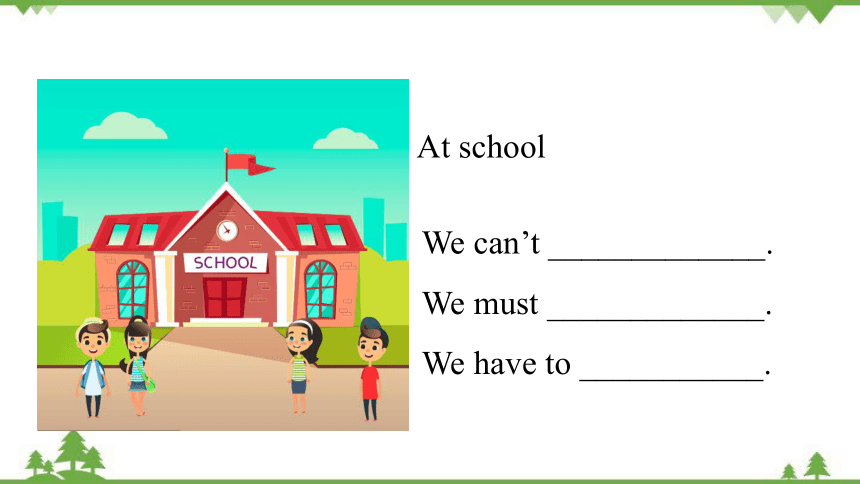



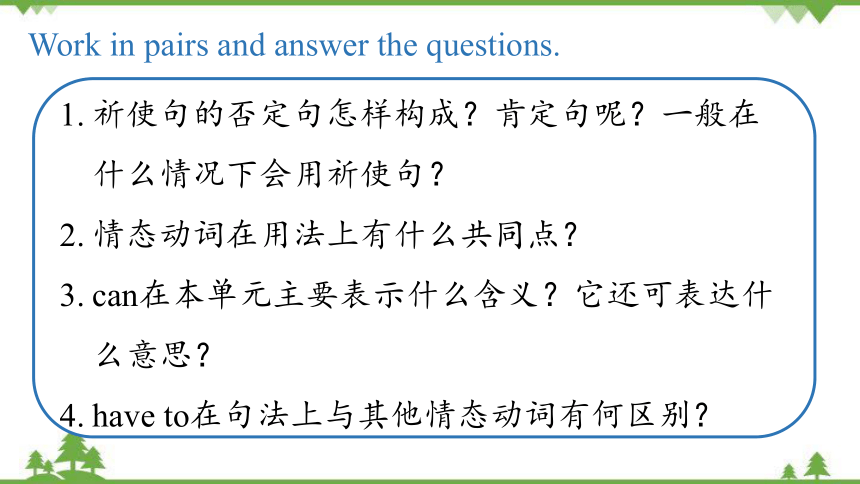
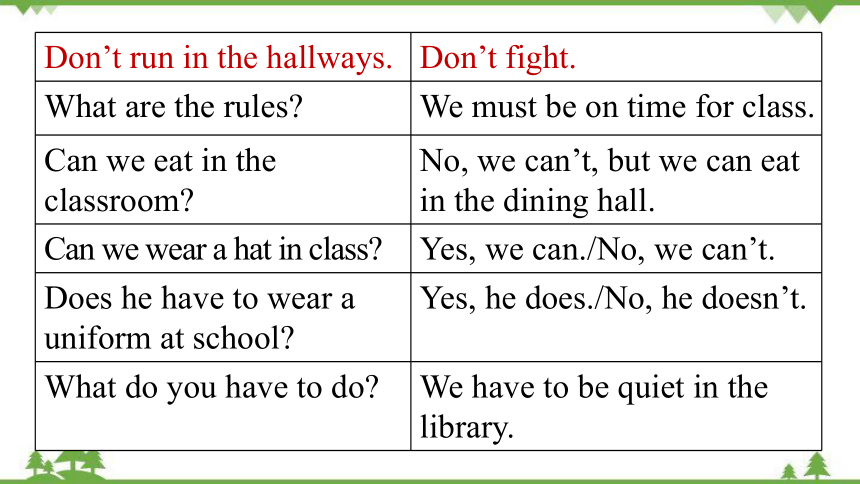
文档简介
(共44张PPT)
Section A Grammar Focus-3c
Unit 4 Don’t eat in class.
初中英语
七年级下册 RJ
Grammar:
① 祈使句(重点为否定结构)
② 情态动词can表“许可”的用法(肯定及否定陈述, 一般疑问句结构及肯定和否定回答)
③ 情态动词must的句型结构(仅限肯定陈述)
④ 情态动词have to的句型结构(肯定及否定陈述,一般疑问结构及肯定和否定回答)
Learning goals
Mine sweeping
扫雷游戏
单词下埋着6颗雷,学生选择单词并读出,
如果单词下没有雷则可得分,如果有,则不得分。
Game time
Warming up
1
1
3
3
1
2
2
2
2
wear
fight
be quiet
school
uniform
sorry
dining hall
bring
must
have to
don’t
school rules
eat in class
1
3
1
1
4
2
run in
the hallways
arrive late
for class
listen to
on time
outside
important
hall
can
In class
We can’t _____________.
We must _____________.
We have to ___________.
Brainstorm
At school
We can’t _____________.
We must _____________.
We have to ___________.
At home
I can’t _____________.
I must _____________.
I have to ___________.
How to talk about rules
Don’t run in the hallways. Don’t fight.
What are the rules We must be on time for class.
Can we eat in the classroom No, we can’t, but we can eat in the dining hall.
Can we wear a hat in class Yes, we can./No, we can’t.
Does he have to wear a uniform at school Yes, he does./No, he doesn’t.
What do you have to do We have to be quiet in the library.
Read and observe this chart.
Grammar Focus
祈使句的否定句怎样构成?肯定句呢?一般在什么情况下会用祈使句?
情态动词在用法上有什么共同点?
can在本单元主要表示什么含义?它还可表达什么意思?
have to在句法上与其他情态动词有何区别?
Work in pairs and answer the questions.
Don’t run in the hallways. Don’t fight.
What are the rules We must be on time for class.
Can we eat in the classroom No, we can’t, but we can eat in the dining hall.
Can we wear a hat in class Yes, we can./No, we can’t.
Does he have to wear a uniform at school Yes, he does./No, he doesn’t.
What do you have to do We have to be quiet in the library.
祈使句的否定句怎样构成?肯定句呢?
祈使句的否定句在动词原形前加don’t,表示“不要做什么事”。
祈使句的肯定句通常是以动词原形开头的。
Don’t run in the hallways. Don’t fight.
What are the rules We must be on time for class.
Can we eat in the classroom No, we can’t, but we can eat in
the dining hall.
Can we wear a hat in class Yes, we can./No, we can’t.
Does he have to wear a uniform at school Yes, he does./No, he doesn’t.
What do you have to do We have to be quiet in the library.
一般在什么情况下会用祈使句?
祈使句一般用于上级对下级,长辈对晚辈之间,表示命令、劝说或警告,也可表示请求。
情态动词在用法上有什么共同点?
can, must, have to后接动词原形。
Don’t run in the hallways. Don’t fight.
What are the rules We must be on time for class.
Can we eat in the classroom No, we can’t, but we can eat in
the dining hall.
Can we wear a hat in class Yes, we can./No, we can’t.
Does he have to wear a uniform at school Yes, he does./No, he doesn’t.
What do you have to do We have to be quiet in the library.
can在本单元主要表示什么含义?它还可表达什么意思?
can在本单元的主要意义是“能够;允许”,还可表示“能力” 。
Don’t run in the hallways. Don’t fight.
What are the rules We must be on time for class.
Can we eat in the classroom No, we can’t, but we can eat in
the dining hall.
Can we wear a hat in class Yes, we can./No, we can’t.
Does he have to wear a uniform at school Yes, he does./No, he doesn’t.
What do you have to do We have to be quiet in the library.
have to在句法上与其他情态动词有何区别?
have to有人称和数的变化。
Don’t run in the hallways. Don’t fight.
What are the rules We must be on time for class.
Can we eat in the classroom No, we can’t, but we can eat in
the dining hall.
Can we wear a hat in class Yes, we can./No, we can’t.
Does he have to wear a uniform at school Yes, he does./No, he doesn’t.
What do you have to do We have to be quiet in the library.
祈使句一般用来表示请求、命令、劝说、号召、警告等。在祈使句中,通常省略主语you,其肯定形式以动词原形开头,否定形式是在动词原形前加don’t。祈使句句尾用句号或感叹号,读时用降调。为表示礼貌,可以在句首或句尾加上please。句末用please时,前面通常加逗号。
语法概述
肯定句:动词原形 (+宾语)+其他.
否定句:Don’t+动词原形 (+宾语) +其他.
Wear the school uniform on weekdays, please. 上学日请穿校服。
Don’t watch TV before dinner. 晚饭前不要看电视。
Do 型祈使句的构成
肯定句:Be+表语+其他.
否定句:Don’t+be+表语 +其他.
Be careful next time.下次要细心。
Don’t be late for school! 上学不要迟到!
Be 型祈使句的构成
肯定句:Let sb. do sth.+其他.
否定句:Don’t+let sb. do sth.+其他.
或Let sb. not do sth.+其他.
Let’s have a rest. 咱们休息一下吧。
Don’t let him go swimming. = Let him not go swimming. 不要让他去游泳。
Let 型祈使句的构成
其他类型的否定祈使句
(1) No+v-ing! / No+名词!
No fishing! 禁止钓鱼!
No parking! 禁止停车!
No photos! 禁止拍照!
(2) never 代替don’t 来加强语气。
Never give up! 决不放弃!
情态动词have to与must
语法示例
We must be on time. 我们必须准时。
Does he have to wear a uniform at school 他在学校必须穿校服吗?
He has to live at school because his home is far away from school. 他不得不住校,因为他家离学校很远。
Grammar Focus
二者均可表示“必须”,其后均接动词原形。
It’s too late. I have to take a taxi. 太晚了,我必须乘出租车。
I must go now. 我必须现在就走。
have to与must的共同点
have to与must的不同点
have to 强调因客观因素影响而不得不做某事,跟主观意愿无关,通常上下文中会有暗示客观因素的句子,多译为“不得不”。
must 表示因主观需要或责任感的驱使而有必要或义务去做某事,多译为“必须”。
have to 可用于不同的时态,有人称和数的变化,其一般现在时的第三人称单数形式为has to;过去式为had to。
must 一般只用来表示现在,没有人称和数的变化。
have to have to的否定形式为don’t/doesn’t /
didn’t have to,表示“不必”。
must must的否定形式为mustn’t,表示“禁止,不准“。
He has to leave school because his family is poor. 因为家里穷,他不得不退学。(受客观因素影响)
We must do something about it. 关于这件事我们必须做点什么。(责任感的驱使)
【拓展】以must开头的一般疑问句的肯定回答用must,否定回答用needn’t或don’t have to。
—Must I leave now 我现在必须离开吗?
—Yes, you must./No, you needn’t (don’t have to). 是的,你必须。/不,你不必。
Look at the pictures in 3a and answer the questions.
1
2
3
4
1. What can’t students do in
picture 2
2. Can we talk loudly/eat/listen to music/take photos in the library
3. Where can you see these signs
3a Write the rules for the school library.
Library Rules
1. ____________________________
2. ____________________________
3. ____________________________
4. ____________________________
Don’t talk.
1
2
3
4
Don’t eat in the library.
Don’t listen to music in the library.
Don’t take photos in the library.
Q:__________________________________
(he/have to/in the dining hall)
A:__________________________________
3b Use the words to make questions about the rules. Then write answers according to your school.
Q: Does she have to be quiet in the library (she/have to/in the library)
A: Yes, she does.
Be quiet
Does he have to eat in the dining hall
Yes, he does.
Eat
Q:_________________________________
(we/can/in the hallways)
A:_________________________________
Listen to music
Can we listen to music in the hallways
No, we can’t.
Wear a hat
Q:_________________________________
(we/can/in the classroom)
A:_________________________________
Can we wear a hat in the classroom
No, we can’t.
wear a hat
Listen to music
Eat
Do we have any library rules in our school Ask and answer in pairs.
Do you have to... in the library
Yes,.../No,...
Be quiet
the students/have to/clean classroom/every day
she/have to/be at home/at five o’clock
she/have to/do morning reading/every day
we/can/arrive at school/late
Make more conversations using these words.
3c Make up five cool rules for your dream school. Share your rules with the class. Your classmates vote for the Coolest School!
1. We can eat in class.
2. We don’t have to come to school every day.
3. ...
At my dream
school, we don’t have
to come to school
every day. We...
一、单项选择
1. David, _______ make trouble at school.
can’t B. don’t C. doesn’t
2. —Mom, can I play computer games this evening
—_______ your homework first, and then we’ll talk about it.
A. Finishing B. Finish C. To finish D. Finished
B
B
Exercises
3. Buses _______ stop when the traffic lights turn red.
A. can B. may C. must
C
4. We should keep quiet in the library. We _____ speak loudly( 大声地).
A. must B. mustn’t C. can D. needn’t
B
5. I _____ go now, or I’ll miss my train.
A. can B. might C. must D. could
6. He _____ stay at home, because it’s raining outside.
A. have to B. has to C. must D. can’t
B
C
二、句型转换(每空一词)
1. Talk in class. (改为否定句)
______ ______ in class.
2. I have to do my homework after school. (对画线部分提问)
______ ______ you ______ ______ ______ after school
Don’t
talk
What
do
have to do
3. We have to listen to the teacher. (改为一般疑问句,并作肯 定回答)
______ we ______ ______ listen to the teacher
______, we ______.
Do
have to
Yes
do
4. She has to wear the uniform at school. (改为一般疑问句,并作肯定回答)
_____ she _____ to wear the uniform at school
_____, she _____.
5. We can run in the hallways. (改为否定句)
We _____ run in the hallways.
Yes does
Does have
can’t
①祈使句(肯定及否定结构)
②情态动词can表“许可”的用法
(肯定及否定陈述,一般疑问句
结构及肯定和否定回答)
③情态动词must的句型结构
(仅限肯定陈述)
④情态动词have to的句型结构(肯
定及否定陈述,一般疑问结构 及肯定和否定回答)
Summary
Grammar
学校组建了一个音乐俱乐部,现在向全体同学征求俱乐部规则,请用英语写出你的合理建议,至少五条。
Homework
THANKS
谢谢聆听!
Section A Grammar Focus-3c
Unit 4 Don’t eat in class.
初中英语
七年级下册 RJ
Grammar:
① 祈使句(重点为否定结构)
② 情态动词can表“许可”的用法(肯定及否定陈述, 一般疑问句结构及肯定和否定回答)
③ 情态动词must的句型结构(仅限肯定陈述)
④ 情态动词have to的句型结构(肯定及否定陈述,一般疑问结构及肯定和否定回答)
Learning goals
Mine sweeping
扫雷游戏
单词下埋着6颗雷,学生选择单词并读出,
如果单词下没有雷则可得分,如果有,则不得分。
Game time
Warming up
1
1
3
3
1
2
2
2
2
wear
fight
be quiet
school
uniform
sorry
dining hall
bring
must
have to
don’t
school rules
eat in class
1
3
1
1
4
2
run in
the hallways
arrive late
for class
listen to
on time
outside
important
hall
can
In class
We can’t _____________.
We must _____________.
We have to ___________.
Brainstorm
At school
We can’t _____________.
We must _____________.
We have to ___________.
At home
I can’t _____________.
I must _____________.
I have to ___________.
How to talk about rules
Don’t run in the hallways. Don’t fight.
What are the rules We must be on time for class.
Can we eat in the classroom No, we can’t, but we can eat in the dining hall.
Can we wear a hat in class Yes, we can./No, we can’t.
Does he have to wear a uniform at school Yes, he does./No, he doesn’t.
What do you have to do We have to be quiet in the library.
Read and observe this chart.
Grammar Focus
祈使句的否定句怎样构成?肯定句呢?一般在什么情况下会用祈使句?
情态动词在用法上有什么共同点?
can在本单元主要表示什么含义?它还可表达什么意思?
have to在句法上与其他情态动词有何区别?
Work in pairs and answer the questions.
Don’t run in the hallways. Don’t fight.
What are the rules We must be on time for class.
Can we eat in the classroom No, we can’t, but we can eat in the dining hall.
Can we wear a hat in class Yes, we can./No, we can’t.
Does he have to wear a uniform at school Yes, he does./No, he doesn’t.
What do you have to do We have to be quiet in the library.
祈使句的否定句怎样构成?肯定句呢?
祈使句的否定句在动词原形前加don’t,表示“不要做什么事”。
祈使句的肯定句通常是以动词原形开头的。
Don’t run in the hallways. Don’t fight.
What are the rules We must be on time for class.
Can we eat in the classroom No, we can’t, but we can eat in
the dining hall.
Can we wear a hat in class Yes, we can./No, we can’t.
Does he have to wear a uniform at school Yes, he does./No, he doesn’t.
What do you have to do We have to be quiet in the library.
一般在什么情况下会用祈使句?
祈使句一般用于上级对下级,长辈对晚辈之间,表示命令、劝说或警告,也可表示请求。
情态动词在用法上有什么共同点?
can, must, have to后接动词原形。
Don’t run in the hallways. Don’t fight.
What are the rules We must be on time for class.
Can we eat in the classroom No, we can’t, but we can eat in
the dining hall.
Can we wear a hat in class Yes, we can./No, we can’t.
Does he have to wear a uniform at school Yes, he does./No, he doesn’t.
What do you have to do We have to be quiet in the library.
can在本单元主要表示什么含义?它还可表达什么意思?
can在本单元的主要意义是“能够;允许”,还可表示“能力” 。
Don’t run in the hallways. Don’t fight.
What are the rules We must be on time for class.
Can we eat in the classroom No, we can’t, but we can eat in
the dining hall.
Can we wear a hat in class Yes, we can./No, we can’t.
Does he have to wear a uniform at school Yes, he does./No, he doesn’t.
What do you have to do We have to be quiet in the library.
have to在句法上与其他情态动词有何区别?
have to有人称和数的变化。
Don’t run in the hallways. Don’t fight.
What are the rules We must be on time for class.
Can we eat in the classroom No, we can’t, but we can eat in
the dining hall.
Can we wear a hat in class Yes, we can./No, we can’t.
Does he have to wear a uniform at school Yes, he does./No, he doesn’t.
What do you have to do We have to be quiet in the library.
祈使句一般用来表示请求、命令、劝说、号召、警告等。在祈使句中,通常省略主语you,其肯定形式以动词原形开头,否定形式是在动词原形前加don’t。祈使句句尾用句号或感叹号,读时用降调。为表示礼貌,可以在句首或句尾加上please。句末用please时,前面通常加逗号。
语法概述
肯定句:动词原形 (+宾语)+其他.
否定句:Don’t+动词原形 (+宾语) +其他.
Wear the school uniform on weekdays, please. 上学日请穿校服。
Don’t watch TV before dinner. 晚饭前不要看电视。
Do 型祈使句的构成
肯定句:Be+表语+其他.
否定句:Don’t+be+表语 +其他.
Be careful next time.下次要细心。
Don’t be late for school! 上学不要迟到!
Be 型祈使句的构成
肯定句:Let sb. do sth.+其他.
否定句:Don’t+let sb. do sth.+其他.
或Let sb. not do sth.+其他.
Let’s have a rest. 咱们休息一下吧。
Don’t let him go swimming. = Let him not go swimming. 不要让他去游泳。
Let 型祈使句的构成
其他类型的否定祈使句
(1) No+v-ing! / No+名词!
No fishing! 禁止钓鱼!
No parking! 禁止停车!
No photos! 禁止拍照!
(2) never 代替don’t 来加强语气。
Never give up! 决不放弃!
情态动词have to与must
语法示例
We must be on time. 我们必须准时。
Does he have to wear a uniform at school 他在学校必须穿校服吗?
He has to live at school because his home is far away from school. 他不得不住校,因为他家离学校很远。
Grammar Focus
二者均可表示“必须”,其后均接动词原形。
It’s too late. I have to take a taxi. 太晚了,我必须乘出租车。
I must go now. 我必须现在就走。
have to与must的共同点
have to与must的不同点
have to 强调因客观因素影响而不得不做某事,跟主观意愿无关,通常上下文中会有暗示客观因素的句子,多译为“不得不”。
must 表示因主观需要或责任感的驱使而有必要或义务去做某事,多译为“必须”。
have to 可用于不同的时态,有人称和数的变化,其一般现在时的第三人称单数形式为has to;过去式为had to。
must 一般只用来表示现在,没有人称和数的变化。
have to have to的否定形式为don’t/doesn’t /
didn’t have to,表示“不必”。
must must的否定形式为mustn’t,表示“禁止,不准“。
He has to leave school because his family is poor. 因为家里穷,他不得不退学。(受客观因素影响)
We must do something about it. 关于这件事我们必须做点什么。(责任感的驱使)
【拓展】以must开头的一般疑问句的肯定回答用must,否定回答用needn’t或don’t have to。
—Must I leave now 我现在必须离开吗?
—Yes, you must./No, you needn’t (don’t have to). 是的,你必须。/不,你不必。
Look at the pictures in 3a and answer the questions.
1
2
3
4
1. What can’t students do in
picture 2
2. Can we talk loudly/eat/listen to music/take photos in the library
3. Where can you see these signs
3a Write the rules for the school library.
Library Rules
1. ____________________________
2. ____________________________
3. ____________________________
4. ____________________________
Don’t talk.
1
2
3
4
Don’t eat in the library.
Don’t listen to music in the library.
Don’t take photos in the library.
Q:__________________________________
(he/have to/in the dining hall)
A:__________________________________
3b Use the words to make questions about the rules. Then write answers according to your school.
Q: Does she have to be quiet in the library (she/have to/in the library)
A: Yes, she does.
Be quiet
Does he have to eat in the dining hall
Yes, he does.
Eat
Q:_________________________________
(we/can/in the hallways)
A:_________________________________
Listen to music
Can we listen to music in the hallways
No, we can’t.
Wear a hat
Q:_________________________________
(we/can/in the classroom)
A:_________________________________
Can we wear a hat in the classroom
No, we can’t.
wear a hat
Listen to music
Eat
Do we have any library rules in our school Ask and answer in pairs.
Do you have to... in the library
Yes,.../No,...
Be quiet
the students/have to/clean classroom/every day
she/have to/be at home/at five o’clock
she/have to/do morning reading/every day
we/can/arrive at school/late
Make more conversations using these words.
3c Make up five cool rules for your dream school. Share your rules with the class. Your classmates vote for the Coolest School!
1. We can eat in class.
2. We don’t have to come to school every day.
3. ...
At my dream
school, we don’t have
to come to school
every day. We...
一、单项选择
1. David, _______ make trouble at school.
can’t B. don’t C. doesn’t
2. —Mom, can I play computer games this evening
—_______ your homework first, and then we’ll talk about it.
A. Finishing B. Finish C. To finish D. Finished
B
B
Exercises
3. Buses _______ stop when the traffic lights turn red.
A. can B. may C. must
C
4. We should keep quiet in the library. We _____ speak loudly( 大声地).
A. must B. mustn’t C. can D. needn’t
B
5. I _____ go now, or I’ll miss my train.
A. can B. might C. must D. could
6. He _____ stay at home, because it’s raining outside.
A. have to B. has to C. must D. can’t
B
C
二、句型转换(每空一词)
1. Talk in class. (改为否定句)
______ ______ in class.
2. I have to do my homework after school. (对画线部分提问)
______ ______ you ______ ______ ______ after school
Don’t
talk
What
do
have to do
3. We have to listen to the teacher. (改为一般疑问句,并作肯 定回答)
______ we ______ ______ listen to the teacher
______, we ______.
Do
have to
Yes
do
4. She has to wear the uniform at school. (改为一般疑问句,并作肯定回答)
_____ she _____ to wear the uniform at school
_____, she _____.
5. We can run in the hallways. (改为否定句)
We _____ run in the hallways.
Yes does
Does have
can’t
①祈使句(肯定及否定结构)
②情态动词can表“许可”的用法
(肯定及否定陈述,一般疑问句
结构及肯定和否定回答)
③情态动词must的句型结构
(仅限肯定陈述)
④情态动词have to的句型结构(肯
定及否定陈述,一般疑问结构 及肯定和否定回答)
Summary
Grammar
学校组建了一个音乐俱乐部,现在向全体同学征求俱乐部规则,请用英语写出你的合理建议,至少五条。
Homework
THANKS
谢谢聆听!
同课章节目录
- Unit 1 Can you play the guitar?
- Section A
- Section B
- Unit 2 What time do you go to school?
- Section A
- Section B
- Unit 3 How do you get to school?
- Section A
- Section B
- Unit 4 Don't eat in class.
- Section A
- Section B
- Unit 5 Why do you like pandas?
- Section A
- Section B
- Unit 6 I'm watching TV.
- Section A
- Section B
- Review of Units 1-6
- Unit 7 It's raining!
- Section A
- Section B
- Unit 8 Is there a post office near here?
- Section A
- Section B
- Unit 9 What does he look like?
- Section A
- Section B
- Unit 10 I'd like some noodles.
- Section A
- Section B
- Unit 11 How was your school trip?
- Section A
- Section B
- Unit 12 What did you do last weekend?
- Section A
- Section B
